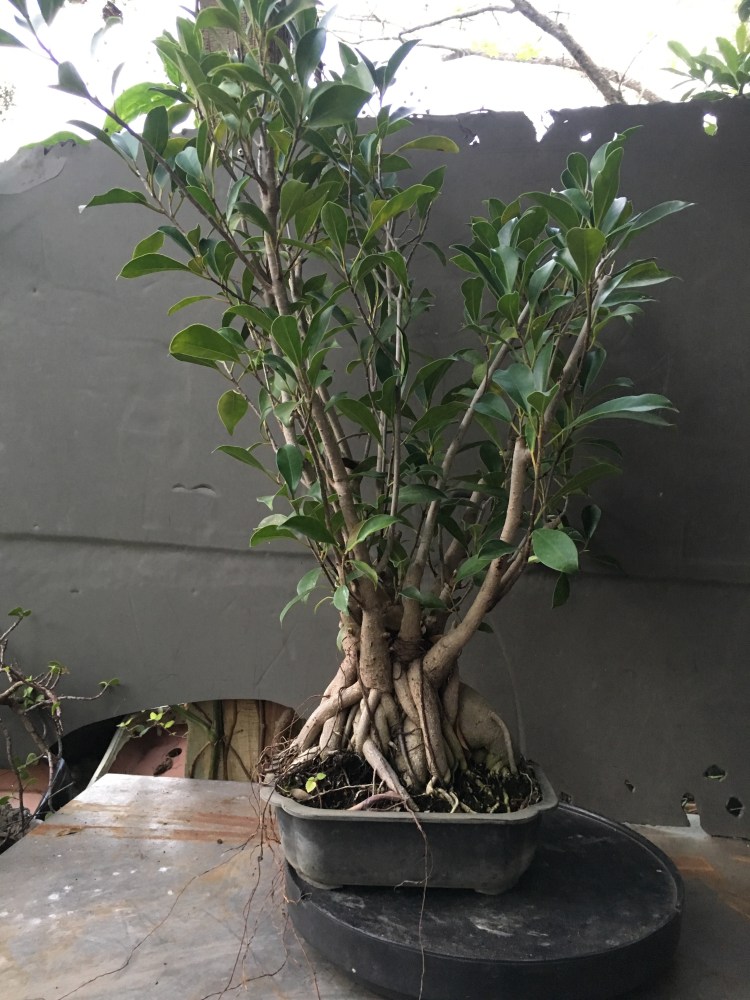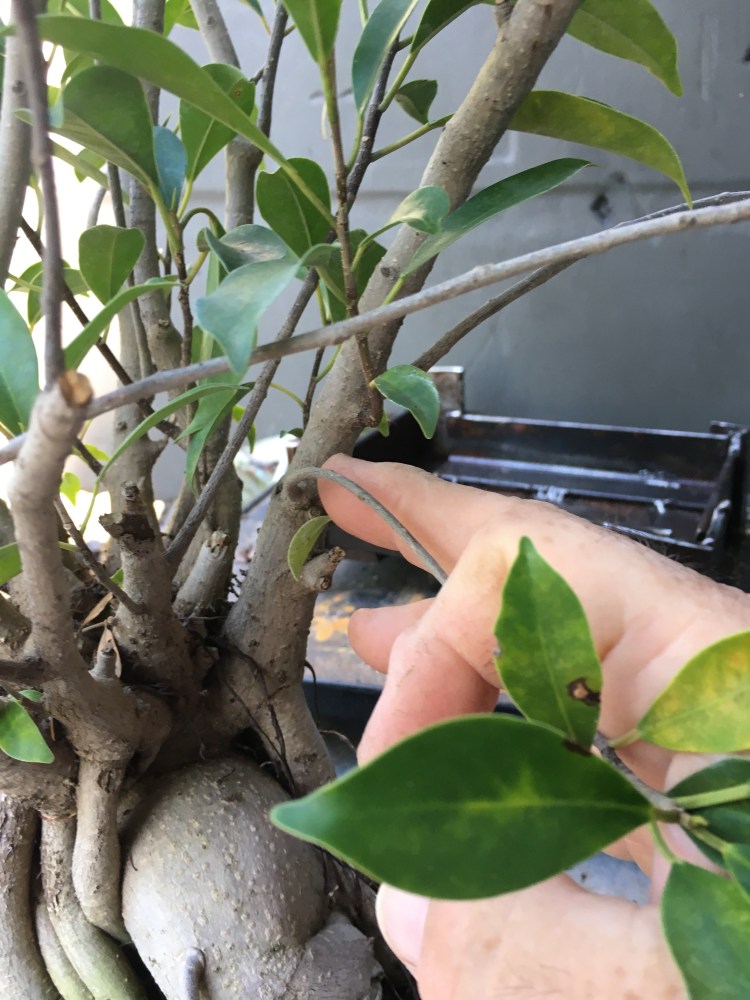I’ve heard that many times.
Well, damn then, I’m jealous of ficus up North. You all have an opportunity I don’t. More on that towards the end. Let’s take a look at some trees then.
This was, in a time long ago and far away, and, as what some of you might know, and what those who might be a little…um…what’s the word…snobbish, call a….ahem, a “ginseng” ficus. There ain’t no such thing, of course, but that’s what many marketing people like to call it. And we all know what those guys are like, I mean, you’ve seen Mad Men right?
Anyway, the above tree started out life just like the typical big box store ficus. Like the ones below:

The trick in choosing one of these trees is to get one with a better trunk shape.

You can read about what I do (or did) to these trees here:
https://adamaskwhy.com/2013/04/07/what-shall-you-do-with-a-ginseng-ficus/
This one below is one I’ve allowed to “escape” into the ground and is just about as tall as I am now.

Can you see it?
 Almost, right?
Almost, right?
How about now?

Here’s a better angle.

My usual advice to develop a trunk on one of these ficus is to take a #3 (three gallon) plastic nursery pot, fill it only about 1/3 full of regular potting soil, stick the ficus in it and place the tree on the ground. Fertilize, water, all the things that go with keeping a plant alive. Notice that I did not say to cut down the pot. The tall walls on the pot help with aerial root formation. It’s both the shade the walls provide and trapping the humidity that’s doing the job.
And time, of course. There’s several things that are certain in the world: Death, Taxes and Bonsai=Time. No matter how good a piece of material may start out as, it needs time to get good.
Here’s another ficus microcarpa I got from Bruce, a guy up in Indiana.

He’s a cool guy, goes around barefoot mostly, kinda like a hippy.

He sells firewood to campers who use it in a state campground he lives on the edge of……wait?!
Where is he from?
Where’s the tree from?
That’s right, I said Indiana.
But how did he get the trunk from the “ginseng”……

To the banyan looking, tropical style, aerial root monster I now have?

He grew it in Indiana now.
With no benefit of the Florida sunshine or humidity or the amazingly talented, spectacularly knowledgable, and superiorly technical (and particularly handsome) benefit of me growing it.
Well, Bruce has a greenhouse and it gets warmth and light in the winter. 
That makes the difference. If you can provide those things, heat and light, then you guys up North (or South, I guess, if you live in the Southern Hemisphere. Let’s call you all the “Equatorial Proximately Challenged”). And you don’t need a greenhouse. My buddy up in Pennsylvania, Rick Skursky (his YouTube channel and his Wire Tree website) has just a basement and very bright lights (and a very deep voice).

I had meant to work this tree after my Midwest Tour but I kinda got caught up in stuff.
So now, instead of choosing branches and writing the second blogpost, I’m working on the initial styling. That’s ok though, it’ll still get where it needs to be. All that other stuff “don’t mean nothing no more”.
Of course, the first “styling” in this case just means cutting the verticals so we can grow some horizontals.
Like here.  That’s a good branch to start with.
That’s a good branch to start with.
And here….

……unfortunately, not all the branches have a branch to cut back to.
 And as you know (or you may not know) these F. microcarpas have a tendency towards dieback. Meaning that when you chop a big branch, that branch will die back to the next branch or a new bud that breaks on the old wood.
And as you know (or you may not know) these F. microcarpas have a tendency towards dieback. Meaning that when you chop a big branch, that branch will die back to the next branch or a new bud that breaks on the old wood.
 So it’s a bit of a guess where this will pop back, but it hopefully will.
So it’s a bit of a guess where this will pop back, but it hopefully will.
Or not.
Then I’ll have to change the plan.
And I do have a plan, you’ll see that at the end. But I understand that the Art I have chosen for my voice, Bonsai, involves a living entity that, contrary to what some artists in bonsai today might think, I am in a partnership with, and it’s not just my voice and vision, but also the nature and character of the tree. If the tree doesn’t want to grow that way, I can’t force it. But I can change the plan.
And I can make it bleed…..
There are times when the trees have made me bleed too, so we are equal.
But it’s respect. Everything I cut off I try to propagate. If it is propagable…… 
Let’s see if this works.
 Trunk fusion and propagation at the same time. I’ll let you know.
Trunk fusion and propagation at the same time. I’ll let you know.
Now, to the root of the subject….
The soil is pretty much as it came, though it is in a bonsai training container.
 Mostly peat moss.
Mostly peat moss.
Now, I’m hearing the gasps and whines about abusing the roots in early November on a tropical. This, believe it or not, is not such a harsh treatment, I mean, I’ve seen and done a lot worse to a ficus than this, promise.
But I shall be protecting this tree from cold weather should we have it anytime soon. That minimum temperature for optimal root growth is 60 f (15.556 c, for the rest of the world). 
Now for the pot. 
I’m going deep this time. Deeper than usual.

A Korean mica pot, for a few reasons. One, I had it sitting next to me…..mostly though, is because a mica pot (due to its materials) will keep the roots warmer in the winter.
A good handful of fertilizer (let’s dispel a myth, shall we? It’s often said that one shouldn’t fertilize a bonsai after repotting, as this will burn the “new” roots as they emerge. Now, there are reasons not to fertilize some specific kinds of trees after repotting, but that has to do with too vigorous growth and long internodes (deciduous trees), but let’s think a little about new roots and fertilizer………..isn’t a tree almost always growing new roots? If we took the axiom the “there should be no fertilizer after a repot” because of new roots getting burnt, then it should follow that one can never fertilize, as, seriously, a tree is almost always growing new roots. Need I go on?)

So we have the ferts applied, and chopsticked in, and now, those with the sharp eyes, are seeing the addition of a new component in my Supermix™️.
 You are seeing some fir bark. I’m testing it in the mix to see how I like it. A lot bigger chunks than pine bark so it won’t break down in the Florida weather so quickly. Hopefully. I’ll let you know how it goes.
You are seeing some fir bark. I’m testing it in the mix to see how I like it. A lot bigger chunks than pine bark so it won’t break down in the Florida weather so quickly. Hopefully. I’ll let you know how it goes.
And lastly, before I put our Indiana ficus to bed (that’s kinda funny as a popular common name is Indian laurel fig. Maybe I’ve found it’s name?)…..
I will defoliate. Yeah, I know, I usually do that first but I got carried away with all that chopping and the philosophy and all that.
Why defoliate? Especially at the onset of winter? Well, last year, and at the beginning of this year, I started experimenting with some ficus. Not to go into too much detail (go back and read this post and this one, and, finally, this one here), but I confirmed my hunch that a tropical tree can and wants to grow in the winter.
So, defoliation!
And these old tired leaves aren’t gonna do much for this ficus. At the most efficient, a trees leaves are only about 5% efficient (to contrast, a solar cell is on average 15% efficient, meaning it can collect only 15% of the suns energy). The leaf below is damaged, stained, yellowing. I might even say that the ficus is using energy keeping this leaf alive instead of the leaf giving energy to the tree.
 Off it goes!
Off it goes!
But! I am keeping all the grow tips intact (that pointy thing at the end of the branch, called a stipule on a ficus).
 This means that the tree doesn’t need to use extra energy making the hormone auxin.
This means that the tree doesn’t need to use extra energy making the hormone auxin.
Speaking of hormones……did you know that rotting leaves give off a hormone in the form of a gas, called ethylene. Most research into ethylene is in the form of ripening fruits, but it does an amazing amount of things in a plant. One of these is to increase root hair growth (the root hairs are the most productive part of the root as far as water, oxygen, and nutrient uptake).
And now, reading the above, you are now looking at the below pic and trying to figure out where I’m going with this tid bit, right?
 It could be argued that leaving the leaves on the soil surface will be a useful technique to increase root growth. But, BUT…..unfortunately, ethylene inhibits root lengthening. In this case, we need longer roots. So I’ll remove the leaves.
It could be argued that leaving the leaves on the soil surface will be a useful technique to increase root growth. But, BUT…..unfortunately, ethylene inhibits root lengthening. In this case, we need longer roots. So I’ll remove the leaves.
But, maybe, in the case of a tree that I didn’t just repot, I’d get better root mass growth if I left the leaves? That sounds like something to try.
And, with all that to think about, I’ll “leave” the tree alone to grow. 
To conclude today’s visit, I’ll share my vision for the tree in the future.
 Something kinda like this. The “Indiana Laurel Banyan”
Something kinda like this. The “Indiana Laurel Banyan”
Not too pretentious, just a tree.
Sometimes that’s all the story a bonsai needs.
Never mind the ficus (amazing), what about Aberfeldy relegated as a wing man to the ficus?…..:)))) Now, I’ll go back and read the post again, thank you, I look forward to your blog. Hope you are well.
LikeLike
As informative and entertaining as usual; always learn something new through your posts! Cheers!!!
LikeLike
Reblogged this on Wolf's Birding and Bonsai Blog.
LikeLike